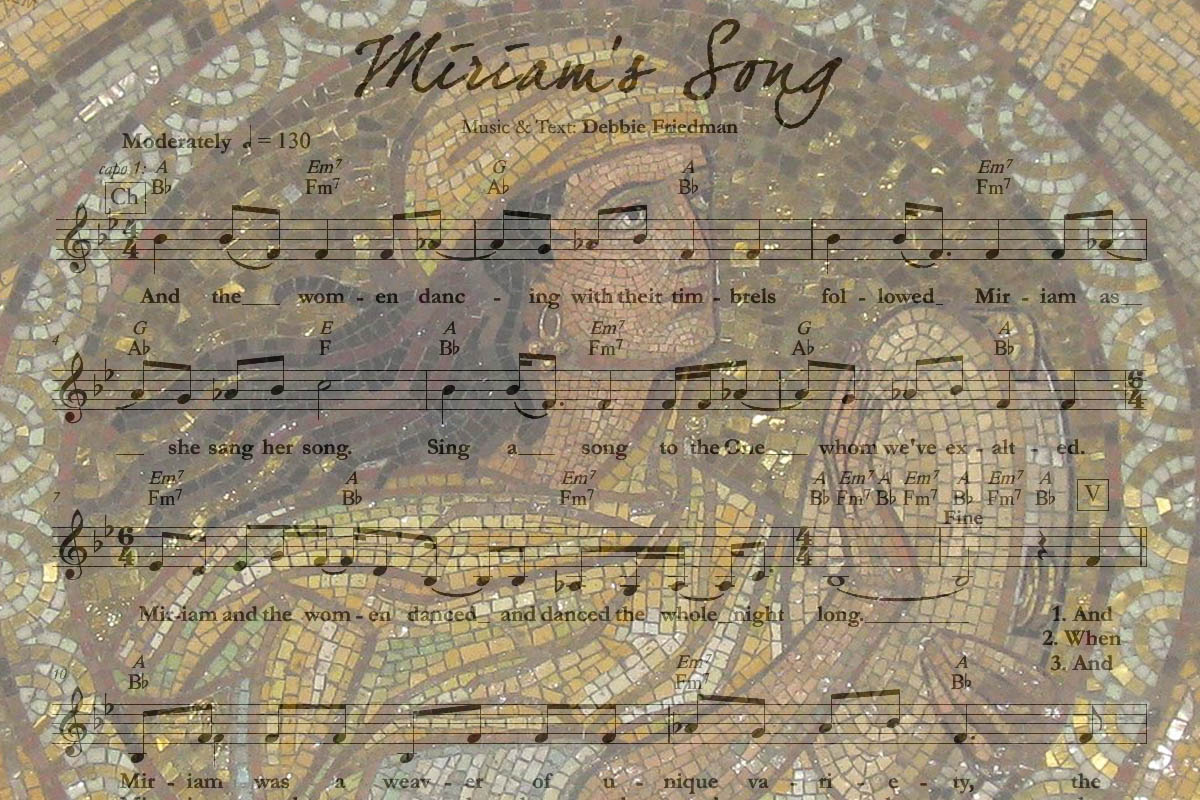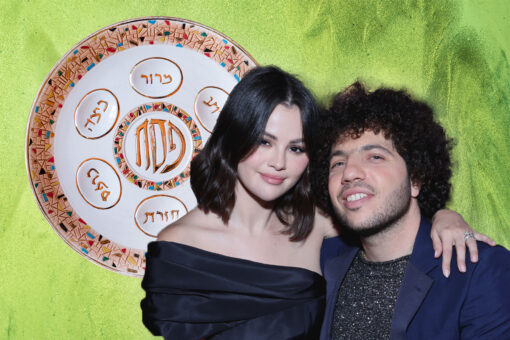When was the last time you got absolutely down jamming to a song about the ancient Israelites’ exodus from Egypt? If the answer is anywhere between never and yesterday, it’s time you listen to “Miriam’s Song” by Debbie Friedman immediately. The 1989 folk classic championed by synagogues and Jewish summer camps alike is — and I cannot stress this enough — a downright banger.
If you’re not familiar with the song, I’m about to spend 1,600 words explaining why it deserves a top slot in every Jewess’s daily rotation, so do yourself a favor and play it on Spotify or YouTube while I take you on a journey of timbrels, ancient dancing, and two Jewish feminist icons.
First, some biblical history (I promise it will be fun). If you remember the basics of the Passover story, you know the big climactic movie magic moment is when Moses parts the Red Sea (with the help of God), the Hebrews walk right on through to safety, and the waters close in on the Egyptian army. The Hebrews, once slaves, are now free! Yay! So what’s their first order of business?
Then Miriam the prophetess, Aaron’s sister, took a timbrel in her hand, and all the women went out after her in dance with timbrels.
And Miriam chanted for them: Sing to the LORD, for He has triumphed gloriously; Horse and driver He has hurled into the sea. [Exodus 15:20-11]
That’s right: After years of slavery and a successful overthrow plot which included frogs, boils, locusts, a shit ton of blood, and the killing of every Egyptian firstborn, the newly free Israelites celebrate by having an honest to God ladies-only dance party singalong.
This is so cool!!!! It’s just like the time I finally got through to my landlord to have the exterminator sent over and after he left, I had a full-on dance party to Lizzo to celebrate the new freedom of living without roaches in my cereal. And here I thought I had nothing in common with our biblical ancestors!
But back to Miriam: If you don’t know much about her, that’s not your fault. Even though the Talmud considers her one of the seven major female prophets of Israel, the Bible only refers to her a handful of times (do I need to tell you why? Okay, it’s because of the PATRIARCHY). We learn that she’s Moses’ and Aaron’s sister, she’s a prophet but her prophetic teachings were not recorded (SMDH), she’s shut out of camp when she gets a skin disease (she probably had, like, one pimple, those motherfuckers), and she leads the Israelite woman in song following their successful crossing of the Red Sea.
But why the singing and dancing, and where in the world did the women get timbrels ready-made for the occasion? As Rishe Groner wrote for Alma in “The Badass Biblical Women of Passover,” it’s safe to assume “nobody spends the hours of drum-crafting — slowly threading sinew across skin and wood frame — without an intention to use the magical instrument. Miriam and her posse had a plan, and that plan involved redemption.” It seems that Miriam and her fellow Israelite women specifically planned for the post-escape dance party, even making sure, while leaving their homes in such a hurry they couldn’t wait for bread to rise, that they had their hand drums with them. This is a pretty incredible act of faith — as Melissa Scholten-Gutierrez writes for the Jewish Women’s Archive, “The women knew (or maybe just hoped) that Moses was right, and there was a higher power who would safely lead them out of Egypt, that the slavery was ending for good, and there would be a reason to celebrate again. They knew that whenever these coalesced, they would be ready for the much anticipated celebration.”
In sum: Women are always right, let’s dance.
But wait!!! Weren’t we talking about Debbie Friedman?
For centuries, Jews knew of Miriam’s song but just had to take the Bible’s word for it that it was a nice, celebratory tune. It took until the late 20th century for one woman to actualize the song with lyrics and a melody and my God, was it worth the wait.
Let me first tell you a bit about Debbie Friedman, of blessed memory. Born in 1951 in Utica, New York, Friedman began writing songs in the early ’70s. She’s famous for reimagining Hebrew prayers, repurposing them into popular melodies many congregations still use today. According to her website, “She identified with other young people whose Judaism had no language that spoke to them – or for them.” Case in point: After teaching her version of the V’ahavta prayer at a Jewish youth convention, she noted, “I was stunned when they suddenly put their arms around each other and there were tears rolling down their faces. They were reclaiming this prayer, and it was ours in a musical language they were able to understand… We were reclaiming something that we hadn’t touched, that we had no access to until now.”
Friedman was a staunch feminist. Besides being the first female composer to contribute significantly to popular Jewish liturgy, her songs themselves often shed light on the women’s voices and stories that weren’t given the spotlight in traditional texts. Friedman herself was gay, but didn’t talk publicly about her personal and romantic life. After the New York Times mentioned her sexual orientation in her obituary (yes, she is no longer with us, and yes, it is very sad), reporter Jonathan Mark recalled a conversation he once had with the late singer: “She didn’t want articles about her to waste paragraphs about how much of a lesbian spokesman she should or should not be, instead of focusing on what she wanted to focus on — Jews, music, God and spirituality.”
So, bearing all that in mind, let’s get to what the whole purpose of this piece is: Miriam’s freaking song.
I need you to know that Friedman wrote this song for a friend. According to her website, “When two friends of hers, Savina Teubal and Marcia Cohen Spiegel, decided to mark their 60th birthdays by creating a new ritual called a ‘Simchat Chochmah,’ or Celebration of Wisdom, Debbie wrote music to accompany them, songs which today are among her best-loved and most often sung.” Among them are, you guessed it, “Miriam’s Song.” Which means that if Debbie weren’t a freakin’ saint and just gave her friend a gift card to Bed Bath like we all would have done, we may have never received the gift of this song.
And a gift it is. Right out of the gate we get Debbie’s signature acoustic guitar and a sweet, soothing melody to ease us into the journey we’re about to go on. After a few bars, we’re rewarded with the song’s chorus (cue the timbrels):
And the women dancing with their timbrels
Followed Miriam as she sang her song
Sing a song to the One whom we’ve exalted
Miriam and the women danced and danced the whole night long
There are only three verses, making this an instant singalong classic and perhaps the reason I still remember all the words from when I first heard it at summer camp when I was 12. Up first:
And Miriam was a weaver of unique variety
The tapestry she wove was one which sang our history
With every strand and every thread she crafted her delight!
A woman touched with spirit, she dances toward the light
I love the idea of Miriam crafting her own delight — how deliciously empowering.
When Miriam stood upon the shores and gazed across the sea
The wonder of this miracle she soon came to believe
Whoever thought the sea would part with an outstretched hand
And we would pass to freedom and march to the promised land!
Here again we touch on Miriam’s faith — faith that the miracle will happen, faith she’d march to the promised land. We close with:
And Miriam the prophet took her timbrel in her hand
And all the women followed her just as she had planned
And Miriam raised her voice in song
She sang with praise and might
We’ve just lived through a miracle: We’re going to dance tonight!!
We’re going to dance tonight!!!! I dare you to sing along with this song, get to that moment, and not absolutely lose your shit. As Debbie’s voice drags out the “toniiiiiight” and you hear the shimmer of a timbrel, which, for the record, is basically a tambourine, it’s hard to not feel the spirit of the ancient Israelite women pouring through your veins. I legit just got my period while writing this paragraph — that is the power of Debbie Friedman!!!!
I know they say at the Passover seder, you’re not just supposed to recount the story of Exodus but feel like you’re actually reliving it. I’m sorry to say that dipping my pinkie into a glass of wine while shouting “Lice!” doesn’t typically transport me into the Promised Land, but this song truly does.
And I am not joking when I tell you this song has a coveted spot on my Spotify playlist called “Faves” which I listen to, daily, year-round (…it’s also not the only Friedman song on that playlist, either; “Not By Might, Not By Power” is another one I first heard at camp and literally cannot get enough of). The beauty of “Miriam’s Song” is that it’s not just a Jewish song, and it’s not just a Passover song. It’s a legitimately beautiful, catchy, joyous song that happens to bring an overlooked biblical heroine to the forefront while also accomplishing exactly what it set out to do: make the women dance.
Dying at just 59 years old, we lost Debbie Friedman much too soon. It only makes sense this Passover to honor her spirit by turning up the speakers, blasting “Miriam’s Song,” and dancing through the night, just like our foremothers would have wanted.
Image of Miriam in header: The Dormition Church on Mount Zion in Jerusalem כנסיית הדורמיציון על הר ציון בירושלים



